At a glance, butterflies and moths might seem like distant cousins or even the same creature under different lighting. But have you ever stopped to wonder: Are moths just butterflies? Or is there more to the story than meets the eye?

Although they are part of the same grouping, moths are not a form of butterfly. Moths were around before butterflies even existed.
What is a Moth?
Moths, often seen as the more mysterious counterparts to butterflies, are a diverse group with over 160,000 known species worldwide.
These creatures predominantly rule the night, though there are day-flying moths too. Moths come in various sizes, from the tiny pinhead-sized micro-moths to the grand Atlas moth with a wingspan rivaling a small bird.
Their wings, often earth-toned with intricate patterns, act as camouflage, helping them blend into their surroundings.
Moths have a feathery or filamentous pair of antennae, which they use as sophisticated sensory organs.
While some might see them as mere drab cousins of butterflies, moths have their own unique charm, with many species boasting vibrant colors and striking patterns.
What is a Butterfly?
Butterflies, the diurnal darlings of the insect world, number over 17,500 recognized species.
They’re most active during the day, gracing gardens, meadows, and forests with their vibrant presence.
Butterflies are often brightly colored, with wings displaying a kaleidoscope of patterns ranging from intricate to boldly simple. These colors aren’t just for show; they play a crucial role in mating rituals and act as warning signals to potential predators.
Unlike moths, butterflies have slender, club-shaped antennae. Another distinguishing feature is their posture; when at rest, butterflies fold their wings vertically over their backs.

Evolution
Moths have a rich evolutionary history that predates the dinosaurs. During the Jurassic period, these ancient insects first flapped their wings around 190 million years ago.
Picture a world where colossal creatures roamed, and amidst them, the ancestors of our modern-day moths fluttered under the moonlit skies.
The world underwent significant changes as time progressed, and so did the Lepidoptera family. A new group began to emerge from these early moths: the butterflies.
This evolutionary offshoot adapted to become daytime flyers, developing vibrant colors and patterns on their wings, possibly as a response to the blooming of flowering plants.
These colors not only helped in attracting mates but also played a role in warding off predators.
So, while it’s accurate to say that moths are not butterflies, the reverse holds a grain of truth. Butterflies are essentially a type of moth that adapted to a different way of life. It’s a testament to nature’s ability to diversify and adapt, painting a vibrant picture of evolution in action.
Did Butterflies Really Evolve From Moths?
Recent research has thrown a curveball into our understanding of Lepidoptera evolution.
While it’s widely accepted that butterflies evolved from moths, a 2018 study unearthed butterfly and moth scales preserved in ancient rock cores. These scales, dated around 200 million years old, predate flowering plants by about 10 million years.
This discovery challenges the long-held belief that butterflies evolved alongside flowering plants for mutual benefit in pollination.
Instead, it suggests that early butterflies, or their moth-like ancestors, may have initially evolved to pollinate non-flowering plants, like gymnosperms, before the rise of flowers. This revelation adds a new layer of complexity to the intricate dance of evolution, reminding us that nature often holds secrets waiting to be uncovered.
Myths
When looking at butterflies and moths, countless myths get thrown around, but they’re all untrue:
Moths are Dull
While many moths sport earthy tones, this is far from the truth. Moths come in a dazzling array of colors and patterns.
Some, like the Rosy Maple Moth, flaunt vibrant pinks and yellows, while others, like the Luna Moth, display a serene green with elegant tail streamers.

All Butterflies are Diurnal
While most butterflies are active during the day, there are exceptions. Some species, like the Owl Butterfly, are crepuscular, meaning they’re most active during dawn and dusk.
Moths Always Eat Clothes
Only a tiny fraction of moth species are responsible for munching on our garments. The culprits are usually the larvae of specific species like the Common Clothes Moth.
Most moths prefer natural food sources, from plant matter to other organic materials.
Butterflies are More Important
Both butterflies and moths play vital roles in pollination. In fact, some flowers are specifically adapted to be pollinated by moths at night, showcasing the importance of these nocturnal visitors.
Moths Think Lights Are the Moon
The exact reason moths are drawn to lights remains a mystery, but one popular theory suggests that moths use natural light sources, like the moon, for navigation. Artificial lights can confuse and disorient them, causing the iconic circling behavior.
Butterflies are Harmless; Moths are Pests
Both moths and butterflies have species that can be considered pests, especially in their larval stages. For instance, some butterfly caterpillars can be quite voracious, munching through crops.
Conversely, many moths are harmless and play crucial roles in their ecosystems.







